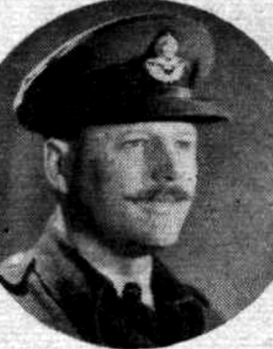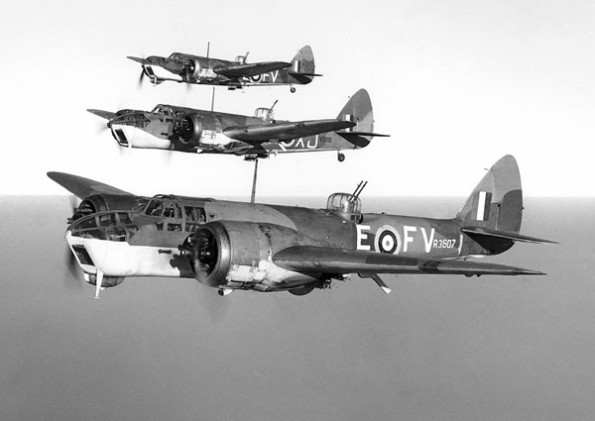
1941 – RAF Bristol Blenheim Bombers were to be Deployed to Malta to support Royal Navy Operations in the Mediterranean, including the Protection of Convoys Transporting Essential Supplies & Personnel to the Island. The Blenheims were also to be Supported by Detachments of 6-Bristol Beaufighters at a time, fitted with Special Equipment to Communicate with Ships. Air Chiefs of Staff in London wanted to send the Heavier Bristol Beauforts to the Island but conditions currently made it impossible to Base them in Malta. A detachment of 6-Bristol Blenheims was expected, with a further 6 possibly to come.
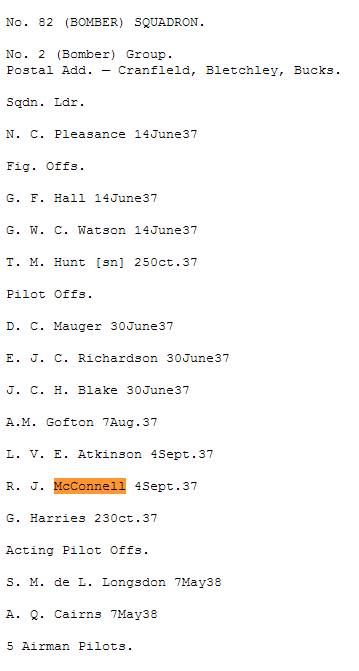
The Officer selected to explore the possibility of Blenheims Operating from Malta against Axis Shipping was Squadron Leader L V E ‘Attie’ Atkinson DSO DFC of No.2-Group, a highly regarded Leader who became a Legend to those who Flew in these Medium Bombers. On 31st March 1941 Squadron Leader ‘Attie’ Atkinson Led 8 of his Crews on 21-Squadron, having been Briefed to Attack Ships off the Dutch Frisian Islands & to open the Campaign against ‘Fringe Targets’. ‘Attie’ Found 2 Destroyers. One was Bombed from 50-ft, with Hits scored on the Ship’s Stern. She slewed round, listing heavily to Port as a column of Black Smoke belched into the Sky. Not content with this success, he then led the Formation across the Islands of the North Dutch Coast, saw a German Troop Parade, dropped his Bombs Plumb between the Ranks & then chased the Regimental Cook up a Lane. Asked by the Intelligence Officer how he could tell it was a Cook, ‘Attie’ replied Soberly that it might have been disguised, but he was wearing a Chef’s Cap & Apron. Then his Observer commented, ‘Dammit, at the height we were Flying we could not only tell that it was a Cook, we could even tell – what the Cook was Thinking.’
‘Attie’s report to Intelligence afterwards was Typical. ‘At Ameland, at about 14.00-hrs,’ he said, ‘we sighted what I suppose must have been an after-Lunch Parade. I alerted my Gunner and we Sprayed the lot of them. After this, we found a fellow on a Gun Emplacement, said ‘Good Afternoon’ and went on our Way.’ Their Visit had not gone unnoticed, for their presence had Attracted a great deal of Flak, which, not too surprisingly, Accounted for 2 of the Blenheims. Another successful Attack saw ‘Attie’ being Awarded a Bar to the DFC. But he missed the Party to celebrate it. On 26th April ‘Attie’ took-off Leading 6-Crews of 21-Squadron on their Flight out to Malta, which all of them completed successfully. On their Arrival they Flew a number of Shipping Sorties, having their Aircraft Serviced by Naval Personnel, losing 1-Aircraft in an Air-Raid. ‘Attie’ led the 1st-Attack on a Convoy to Tripoli & personally Sank a 4,000-Tonner, while others in the Flight Sank a Destroyer. There were 4 more Attacks on Convoys & then the Blenheims came Home, Flying all the way from the Bay of Biscay to England on 1-Engine. Sea-spray had got in the other. Atkinson ran out of Fuel & had to make an undignified, but safe, Belly Landing in a friendly Cornish Field. ‘Attie’ was then Posted back to his own Original 82-Squadron at RAF Watton. The man from Church House who had joined them as Acting Pilot Officer was, at 26-yrs, in Command of the Squadron. Some of the men who were now with him had Survived from Gembloux, the Squadron had been virtually Wiped-out on the Raid on 17th May 1940, but most of the Faces were New. Wing Commander Atkinson Flew again to his familiar Base at Luqa, in Malta taking his Squadron with him.
As Squadron Commander ‘Attie’ often went out himself after the Ships. Ship-Sinking was a matter of Gambits. Most frequently the Big Cargo-Ships & even the smaller Fry for Rommel would be accompanied by a Single Italian Destroyer. The Blenheims would Fly around, looking for an Opening, while the Destroyer would frantically Circle her Charge, sending up showers of ‘Spray’ in an effort to get between the Attacking Blenheims & the Cargo-Ship. The game was Hard on both sides, ending sometimes in the Loss of both Italian Ships, Guardian & Ward & sometimes with the Loss of the Blenheims. On his return, Atkinson reported that the situation in Malta was far from satisfactory, things having been neglected for years. However, he considered the Plan Feasible to Operate there on a Squadron, or ‘Squadron Plus’ basis. On receipt of Atkinson’s Report, Sir Charles Portal sent for the Senior Air Staff Officer (SASO) of No.2-Group, Group Captain Hugh Pughe-Lloyd, to tell him he had been selected to Command the Detachments of No.2 Group in Malta. His brief was ‘to Sink Axis Shipping between Europe & Africa’. It was, in effect, the same task in which the Aircrew of No.2 Group in the UK were already involved in over the Seas off occupied Western Europe.

On his arrival in Malta, Pughe-Lloyd [who enlisted as a Private in WW1 and stayed on with the British Army to receive a Knighthood for his Defence of Malta] was horrified to find Defences & Facilities in a deplorable state, Airfields ill-prepared as Operational Bases. Little thought had obviously been given to the use of the Island as a Base from which Fighter or Bomber Aircraft could Operate. It is to his considerable credit that the Aerodrome at Luqa was soon made ready for the arrival of the 1st Detachment of Blenheims.
A Detachment was sent to Malta in May 1941, with the rest of the Squadron following on 11th June where they were transferred to Squadrons already on the Island. It flew Operations against Enemy Shipping & Ports through into July, but extremely Heavy Losses lead to it being withdrawn, back to the UK at the end of the month, being replaced by No.110 Squadron.
The 1st Squadron to be Detached to Malta was No.82 Squadron RAF Watton, Commanded by Atkinson, now a Wing Commander, whose presence had been specifically Requested by Pughe-Lloyd, now an Air Commodore. The 1st Aircraft to leave England, led by Atkinson, took-off on 4th June, followed a week later by a further 9-Blenheims. All of the Aircraft carried in addition to their Aircrew, 2 unfortunate Ground-Crew sitting as comfortable as possible in the Well of the Aircraft. They all arrived safely, although the Last of the Crews had to Land after Dark, using a Flarepath which some character, fearful of Enemy Bombing Raids, did his best to Extinguish.
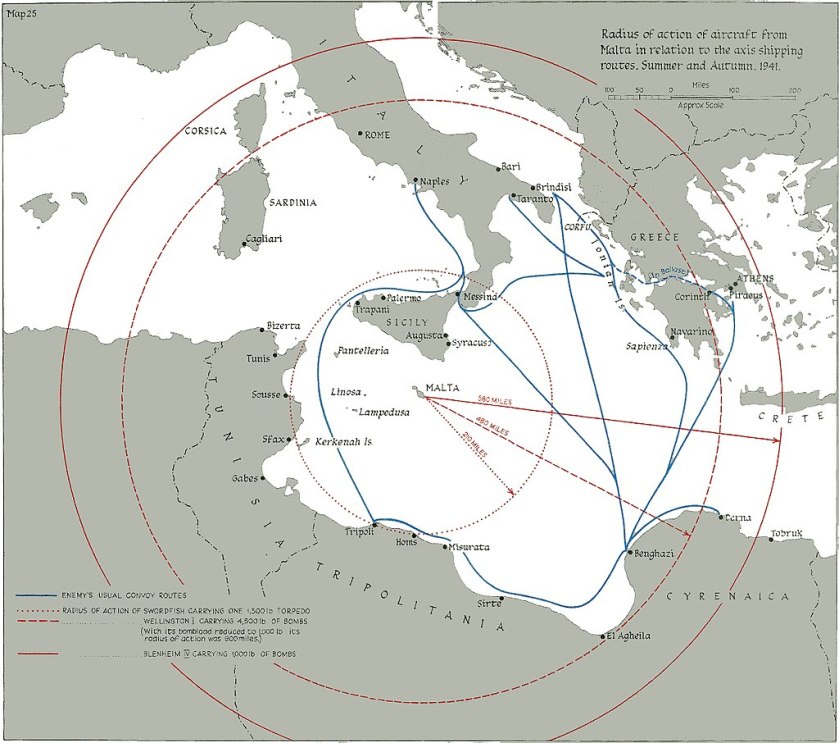
Apart from the Hurricanes on Malta, there were 7-Twin-Engined Martin Maryland Reconnaissance Aircraft, a Squadron of Wellingtons & a number of Swordfish Bi-planes of the Fleet Air Arm.
The Role of the Martin Model 167 Marylands was to Reconnoitre for Enemy Shipping, keeping a special eye on Naples for signs of Sailings or the assembling of Convoys for the Journey to Africa. On receipt of reports of the movement of Enemy Shipping, Attacks would be Launched during the Day by Blenheims & Swordfish, with the Wellingtons Operating at Night. The Enemy Convoys from Naples carrying Supplies to the Axis Armies in North Africa followed Routes which brought them no closer than 140-miles from Malta. Either Sailing to the West of Sicily, then Directly across to Africa, staying Close to the Shore until they reached Tripoli, or through the Straits of Messina, then East to Greece before turning South to Benghazi.
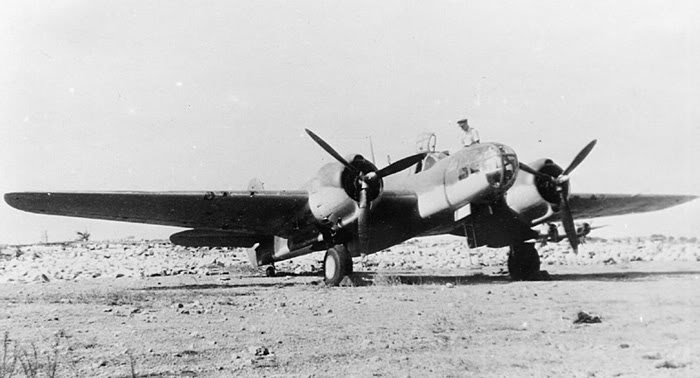
South of Pantelleria on 22nd June, a biggish Convoy Escorted by Destroyers & Enemy Fighters was Found by 6-Crews of No.82 Squadron. The Aircrews went into the Attack in the manner they had perfected over the North Sea, despite intense Anti-Aircraft Fire & the Presence of the Fighters. The Crew of one Blenheim, Flight Lieutenant T J Watkins Pilot, Sergeant Observer J S Sargent & Sergeant W-Op/Air Gunner Eric F Chandler, dropped their Bombs Gaining Hits on a Merchantman. Their Aircraft was badly Damaged by Flak, the Explosion of one almost severing Watkins‘ Leg. Despite severe pain & shock, he managed to Right the Aircraft, giving Sargent time to come to his Aid. Meanwhile, Chandler was doing Battle with an Italian Fiat CR42 Falco Bi-plane Fighter, which he succeeded in Shooting Down, which earned him a DFM.
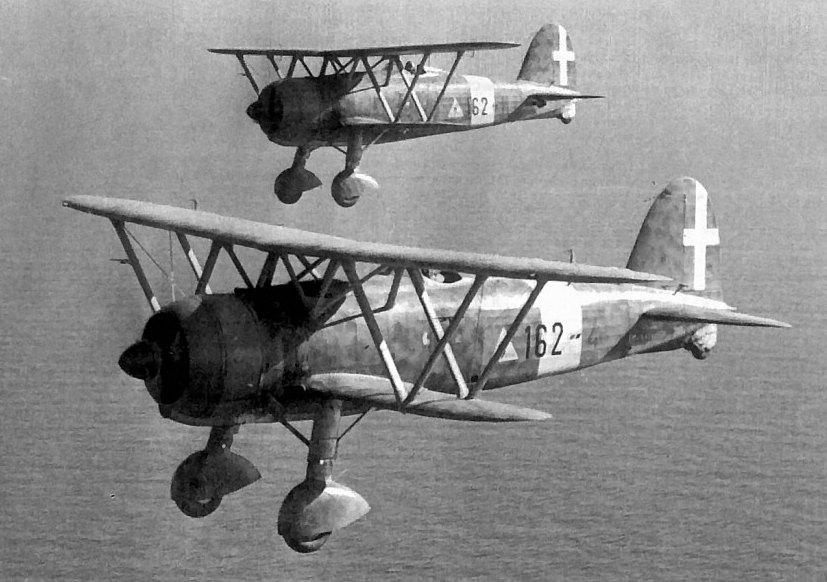
Showing immense Courage Watkins managed to stay Conscious during the long Flight back to Luqa to give Sargent Flying Instructions, where miraculously Watkins brought the Aircraft safely into Land at Luqa & then Collapsed. Watkins was Awarded an immediate DSO, Sargent & Chandler, who was credited with having Shot Down an Enemy Fighter, each received the DFM. The Damage to their Aircraft was so severe it had to be Written off. By a strange twist of fate, 3-months later, on their return to England, Sargent & Chandler were Flying a Shipping Sweep off the Frisian Islands when their Pilot, Flight Lieutenant Bartlett was Injured. Sargent Flew their Aircraft back to Base, Landing it successfully despite a Live Bomb onboard. As soon as their Aircraft came to a Stop, Sargent & Chandler leapt out dragging their Wounded Pilot between them before the Bomb Exploded.
Malta: Blenheim Shot Down off Lampedusa – July 1941: A Blenheim Aircraft of 82-Squadron has been reported Missing after it was Shot Down during a Raid on Enemy Shipping in the Southern Mediterranean. F/Lt A B Broadley’s Blenheim was the Lead Aircraft of 3 sent to Attack Axis Ships off the Island of Lampedusa. The Blenheims scored direct Hits on the Ships but faced very Heavy Defensive Fire, during which F/Lt Broadley’s Bomber was Hit & Forced to Land in the Sea half a mile Offshore. The Air Gunner of a 2nd Blenheim was injured. The other 2-Members of the Missing Blenheim Crew have been named as Wireless Operator/Air Gunner Sgt V Marsh & Observer Pilot Officer A S Ramsay. All 3 arrived in Malta less than a month ago.
Speed Limits Vital for Fuel Economy: The Attention of Service Personnel has been drawn to the persistent disregard of the Regulations Governing the Speed of Motor Transport. This Violation of Regulations not only renders Offenders liable to Disciplinary Action but is an extravagant use of Petrol, as the Authorised Speeds are the most Economical. The Speed Limits for all Military Mechanised Transport in Valletta & in all Towns & Villages are 25-mph for Motor Cars & 15-mph for all other Vehicles. Vehicles found exceeding this Speed will be stopped & reported to Command Headquarters. In the event of it being proved that the Vehicle Exceeded the approved Speed, the Driver (if a Soldier) will forfeit his Leave for 2-months.
